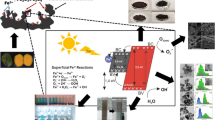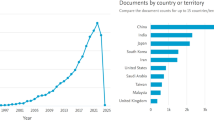Abstract
The purpose of the present work was to prepare a series of pigments SrVxSn1−xO3 (x = 0; 0.025; 0.05; 0.1; 0.2 and 0.3) by classical ceramic method and by simulation of ‘mixer dryer reactor’ in the temperature range 1,300–1,500 °C. These compounds belong to group of high-temperature pigments. The principal of these pigments makes the host lattice of the SrSnO3, which is doped by vanadium ions. This incorporation of the doped ions leads to obtaining of the interesting yellow colour after application into the organic matrix. The fired pigments were characterised by TG-DTA analysis, scanning electron microscopy and colour measurements. The particle size was measured and X-ray diffraction analysis was also performed to define character of the new compounds. Pigments of brighter yellow colour were obtained for the V concentration 0.025 at calcination temperature 1,475 °C. Most pigments meet given range of the mean particle size distribution d 50, which is a necessary condition for the pigments to be applicable in a binder.




Similar content being viewed by others
References
Lewis PA. Pigment handbook, vol. 1. New York: Wiley; 1998. p. 7.
Bonamartini CA, Ferrari AM, Leonelli C, Manfredini T, Pellacani GC. Synthesis and methodologies in inorganic chemistry. New Compd Mater. 1996;6:145–51.
Barros BS, Costa ACFM, Kiminami RHAG, Gama L. Preparation and characterization of spinel MCr2O4 (M = Zn, Co, Cu and Ni) by combustion reaction. J Metastable Nanocryst Mater. 2004;20–21:325–32.
Melo D, Marinho RMM, Vieira FTG, Lima SJG, Longo E, Souza AG, Maia AS, Santos IMG. Influence of Cu(II) in the SrSnO3 crystallization. J Therm Anal Cal. 2011;106:513–7.
Dohnalová Ž, Šulcová P, Trojan M. Preparation and selected properties of pigments on base of Ln-doped CaSnO3. J Therm Anal Cal. 2008;93:857–61.
Vieira FTG, Oliveira ALM, Melo DS, Lima SJG, Longo E, Maia AS, Souza AG, Santos IMG. Crystallization study of SrSnO3:Fe. J Therm Anal Cal. 2011;106:507–12.
Wu J. Defect chemistry and proton conductivity in Ba-based perovskites. Pasadena: California Institute of Technology; 2005.
Smith MG, Goodenough JB, Mathiram A, Taylor RD, Peng W, Kimball CW. Tin and antimony valence states in BaSn0.85Sb0.15O3−δ. J Solid State Chem. 1992;98:181–6.
Balboul BAA. The solid state reaction between lanthanum oxide and strontium carbonate. Thermochim Acta. 2006;445:78–81.
Azad AM, Shyan LLW, Pang TY, Nee ChN. Microstructural evolution in MSnO3 ceramics derived via self-heat-sustained (SHS) reaction technique. Ceram Int. 2000;26:685–92.
Pfaff G. Preparation and characterization of the strontium stannates SrSnO3 and Sr2SnO4. J Mater Sci. 2000;35:3017–21.
Wang S, Lu M, Zhou G, Zhou Y, Zhang A, Yang Z. Systematic investigations into SrSnO3 nanocrystals (I) synthesis by using combustion and coprecipitation methods. J Alloy Compd. 2008;432:265–8.
Alves MCF, Souza AC, Lima SJG, Longo E, Souza AG, Santos IMG. Influence of the precursor salts in the synthesis of CaSnO3 by the polymeric precursor method. J Therm Anal Cal. 2007;87:763–6.
Mesíková Ž, Trojan M, Šulcová P. Conditions of synthesis of Co-Zn-Ti-Cr spinel pigment. Ceram Silik. 2005;49:28–32.
Mesíková Ž, Šulcová P, Trojan M. Synthesis and description of SrSn0.6Ln0.4O3 perovskite pigments. J Therm Anal Calorim. 2008;91:163–6.
Šulcová P, Vitásková L. Preparation and colour properties of Ce1-xTbxO2 pigments. Sci Pap Univ Pardubice. 2007;A131:121–8.
Liptay G. Atlas of thermoanalytical curves. Budapest: Akadémiai Kiadó; 1971.
Gallagher PK, Sanders JP, Woodward PM, Lokuhewa IN. Reaction within the system, 2SrCO3–Fe2O3. J Therm Anal Cal. 2005;80:217–23.
Lide DR. CRC handbook of chemistry and physics. 90th ed. (CD-ROM). Florida: CRC Press/Taylor and Francis; 2010.
Schaber PM, Colson J, Higgins S, Thielen D, Anspach B, Brauer J. Thermal decomposition (pyrolysis) of urea in an open reaction vessel. Thermochimica Acta. 2004;424:131–42.
Bernhard AM, Peitz D, Elsener M, Wokaun A, Kröcher O. Hydrolysis and thermolysis of urea and its decomposition byproducts biuret, cyanuric acid and melamine over anatase TiO2. Appl Catal B. 2012;115–116:129–37.
Joint Committee on Powder Diffraction Standards. Swarthmore: International Centre of Diffraction Data.
Acknowledgements
This work has been supported by University of Pardubice under the project IGA SGFChT04.
Author information
Authors and Affiliations
Corresponding author
Rights and permissions
About this article
Cite this article
Adolfová, L., Dohnalová, Ž. & Šulcová, P. New inorganic pigments based on SrSnO3 doped by V2O5 . J Therm Anal Calorim 113, 161–167 (2013). https://doi.org/10.1007/s10973-012-2931-0
Received:
Accepted:
Published:
Issue Date:
DOI: https://doi.org/10.1007/s10973-012-2931-0




